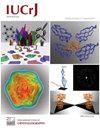SCXRD, CSP-NMRX和microED寻找三种难以捉摸的美洛昔康多态性。
IF 3.6
2区 材料科学
Q2 CHEMISTRY, MULTIDISCIPLINARY
引用次数: 0
摘要
晶体结构的测定是化学科学几乎每个分支的一个重要方面,它使我们更接近于理解结晶、多态性、相变以及结构与其物理化学和功能性质之间的关系。不幸的是,许多分子结晶成微晶粉末,这给建立它们的结构带来了巨大的挑战。在这项工作中,我们使用三种方法描述了消炎药美洛昔康(MLX)的三种难以捉摸的多态性的晶体结构测定,其中每个晶体相只有一种成功。单晶x射线衍射使我们能够求解MLX-III的结构,MLX-II是通过核磁共振晶体学和晶体结构预测(CSP)计算相结合来求解的,而MLX-V (Z′= 4多晶)只能通过电子衍射来求解。通过考虑影响晶体结构测定方法选择的因素,我们展示了它们的优缺点,以表明它们的适用性。此外,我们讨论了MLX-II和MLX-III(都是Z' = 2多态性)的CSP搜索中遇到的问题,除了在结晶实验中也是如此,这些问题在计算上是难以捉摸的。这表明MLX的晶体能量格局复杂,并暗示CSP面临更普遍的挑战。本文章由计算机程序翻译,如有差异,请以英文原文为准。
SCXRD, CSP-NMRX and microED in the quest for three elusive polymorphs of meloxicam
The case of three elusive polymorphs of meloxicam highlights the strengths and weaknesses of single-crystal X-ray diffraction, crystal structure prediction–NMR crystallography and microcrystal electron diffraction as crystal structure determination approaches. Each method was successful in solving only one of the polymorphs, showcasing the advantage of using the whole arsenal of available techniques.
Crystal structure determination is a crucial aspect of almost every branch of the chemical sciences, bringing us closer to understanding crystallization, polymorphism, phase transitions, and the relationship between a structure and its physicochemical and functional properties. Unfortunately, many molecules notoriously crystallize as microcrystalline powders, providing a significant challenge in establishing their structures. In this work, we describe the crystal structure determination of three elusive polymorphs of the anti-inflammatory drug meloxicam (MLX) using three approaches, of which only one was successful for each crystal phase. Single-crystal X-ray diffraction allowed us to solve the structure of MLX-III, MLX-II was solved by a combination of NMR crystallography and crystal structure prediction (CSP) calculations, and MLX-V (Z′ = 4 polymorph) was only solvable using electron diffraction. By considering the factors influencing the choice of crystal structure determination method, we showcase their strengths and weaknesses as an indication of their applicability. Additionally, we discuss the issues encountered in the CSP search for MLX-II and MLX-III (both Z′ = 2 polymorphs) which turned out to be computationally elusive, in addition to being so in crystallization experiments. This indicates a complex crystal energy landscape for MLX and hints at more general challenges in CSP.
求助全文
通过发布文献求助,成功后即可免费获取论文全文。
去求助
来源期刊

IUCrJ
CHEMISTRY, MULTIDISCIPLINARYCRYSTALLOGRAPH-CRYSTALLOGRAPHY
CiteScore
7.50
自引率
5.10%
发文量
95
审稿时长
10 weeks
期刊介绍:
IUCrJ is a new fully open-access peer-reviewed journal from the International Union of Crystallography (IUCr).
The journal will publish high-profile articles on all aspects of the sciences and technologies supported by the IUCr via its commissions, including emerging fields where structural results underpin the science reported in the article. Our aim is to make IUCrJ the natural home for high-quality structural science results. Chemists, biologists, physicists and material scientists will be actively encouraged to report their structural studies in IUCrJ.
 求助内容:
求助内容: 应助结果提醒方式:
应助结果提醒方式:


